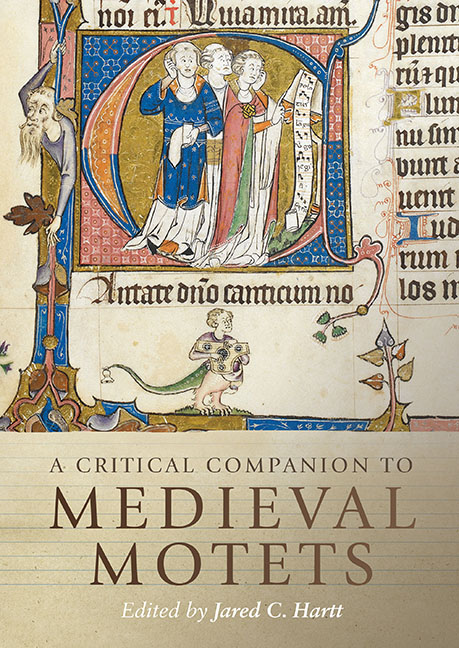Book contents
- Frontmatter
- Dedication
- Contents
- List of Figures
- List of Music Examples
- List of Tables
- List of Contributors
- Preface
- Acknowledgments
- Abbreviations
- Introduction: Approaching Medieval Motets
- 1 The Genre(s) of Medieval Motets
- 2 Origins and Interactions: Clausula, Motet, Conductus
- 3 Tracing the Tenor in Medieval Motets
- 4 Isorhythm
- 5 Notation
- 6 Thirteenth-Century Motet Functions: Views through the Lens of the Portare Motet Family
- 7 A Prism of its Time: Social Functions of the Motet in Fourteenth-Century France
- 8 Motets, Manuscript Culture, Mise-en-page
- 9 Clerics, Courtiers, and the Vernacular Two-Voice Motet: The Case of Fines amouretes / Fiat and the Roman de la poire
- 10 When Words Converge and Meanings Diverge: Counterexamples to Polytextuality in the Thirteenth-Century Mote
- 11 Motets in Chansonniers and the Other Culture of the French Thirteenth-Century Motet
- 12 Building a Motet around Quoted Material: Textual and Musical Structure in Motets Based on Monophonic Songs
- 13 The Duet Motet in England: Genre, Tonal Coherence, Reconstruction
- 14 Materia Matters: Reconstructing Colla/Bona
- 15 Machaut’s Motet 10 and its Interconnections
- 16 A Motet Conceived in Troubled Times: Machaut’s Motet 22
- 17 A Motet Ahead of its Time? The Curious Case of Portio nature/Ida capillorum
- Bibliography of Works Cited
- Select Glossary
- Index of Cited Motets
- General Index
- Studies in Medieval and Renaissance Music
12 - Building a Motet around Quoted Material: Textual and Musical Structure in Motets Based on Monophonic Songs
Published online by Cambridge University Press: 21 October 2020
- Frontmatter
- Dedication
- Contents
- List of Figures
- List of Music Examples
- List of Tables
- List of Contributors
- Preface
- Acknowledgments
- Abbreviations
- Introduction: Approaching Medieval Motets
- 1 The Genre(s) of Medieval Motets
- 2 Origins and Interactions: Clausula, Motet, Conductus
- 3 Tracing the Tenor in Medieval Motets
- 4 Isorhythm
- 5 Notation
- 6 Thirteenth-Century Motet Functions: Views through the Lens of the Portare Motet Family
- 7 A Prism of its Time: Social Functions of the Motet in Fourteenth-Century France
- 8 Motets, Manuscript Culture, Mise-en-page
- 9 Clerics, Courtiers, and the Vernacular Two-Voice Motet: The Case of Fines amouretes / Fiat and the Roman de la poire
- 10 When Words Converge and Meanings Diverge: Counterexamples to Polytextuality in the Thirteenth-Century Mote
- 11 Motets in Chansonniers and the Other Culture of the French Thirteenth-Century Motet
- 12 Building a Motet around Quoted Material: Textual and Musical Structure in Motets Based on Monophonic Songs
- 13 The Duet Motet in England: Genre, Tonal Coherence, Reconstruction
- 14 Materia Matters: Reconstructing Colla/Bona
- 15 Machaut’s Motet 10 and its Interconnections
- 16 A Motet Conceived in Troubled Times: Machaut’s Motet 22
- 17 A Motet Ahead of its Time? The Curious Case of Portio nature/Ida capillorum
- Bibliography of Works Cited
- Select Glossary
- Index of Cited Motets
- General Index
- Studies in Medieval and Renaissance Music
Summary
IN THE THIRTEENTH CENTURY, polyphonic motets and monophonic songs were connected in a number of different ways, many of which are explored by Gaël Saint-Cricq in the previous chapter of this Companion. This chapter focuses on three concrete examples of one particular type of interaction: when a motet voice has been created by quoting the entire first stanza of a monophonic song. Each of these motets demonstrates a different manner in which a motet can fashion itself around the characteristics of a quoted song. In presenting a variety of approaches to building a motet around a song, I not only catalogue different modes of song-motet interaction, but also provide a foundation from which to consider the workings of quotation within the thirteenth-century motet.
In approaching song and motet interaction, it can often be profitable to examine the chronological relationships between motets and songs that borrow significant musical and/or textual material from each other. If, for example, a particular motet can be shown to have quoted from a song, the specifics of this intergeneric borrowing can be examined in much more detail than if that relationship remained unestablished. The three examples addressed in this chapter are part of a corpus of twenty-one motets that include an entire voice part that is also found as the first stanza of a monophonic song.1 The networks of songs and motets in this corpus exhibit different chronologies. In all three cases examined in this chapter, it seems most likely that an earlier monophonic song was quoted in a later motet, moving it from a monophonic to a polyphonic context. In total, this seems the most probable chronology for twelve of the twenty-one cases. In five cases, the reverse seems to have happened: a motet voice was changed into a monophonic song by stripping it of its polyphonic context and adding further stanzas. In the remaining four cases, the extant evidence does not allow for a conclusion to be drawn.
Looking at the interaction between song and motet from the vantage point of the chronology of specific motets and songs is complemented by the more general category of stylistic influence.
- Type
- Chapter
- Information
- A Critical Companion to Medieval Motets , pp. 243 - 260Publisher: Boydell & BrewerPrint publication year: 2018



